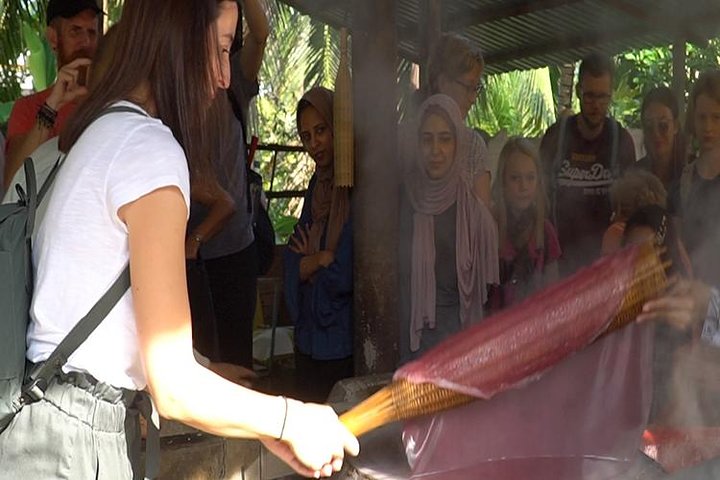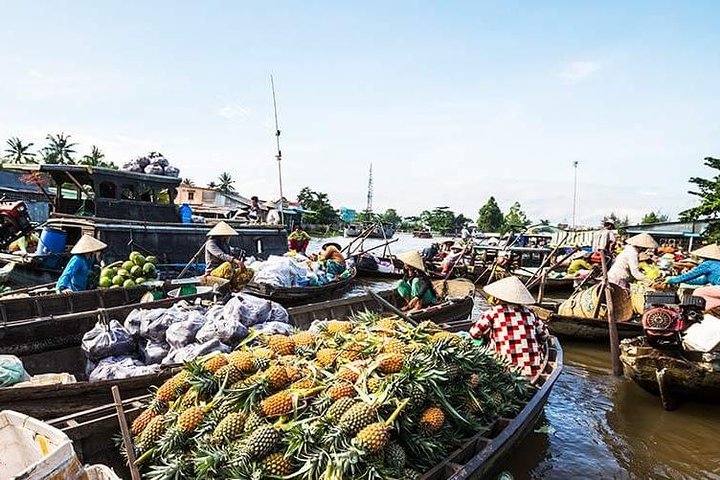- Phu My Port Vietnam - Starting operations 20 years ago in the south of Vietnam, Baria Serece – Phu My Port is being recognized for its high standards in safety, with fast, effective and reliable port services available to the customers 24 hours per day round year. They are strategically located on the Thi Vai River basin, making Baria Serece Phu My Port a great inbound gateway for the cargo that will be distributed within Vietnam, and, also giving to our customers a possibility to outbound cargo thru Asia and world.
Phu My Port is located on Cai Mep-Thi Vai linking-port Road, Phu My District-level Town, Tan Thanh District, Ba Ria Vung Tau Province. Phu My Port is about 40 km from Vung Tau City, 70 km from the center of Saigon, 110 km from Cu Chi Tunnels, 125 km from, Mekong Delta. It takes about 1 hour to Vung Tau City, about 1.5 hours to Ho Chi Minh City, and about 2 hours and 45 minutes to reach My Tho – Mekong Delta from Phu My Port by road way.
You’ll be picked up at main gate of Phu My port to Saigon
-
Binh Tay Market - Located in Chinatown (Cho Lon), Binh Tay Market is a bustling and historic market in Ho Chi Minh City. With a rich history dating back to the late 19th century, the market serves as a vibrant hub of commerce and cultural exchange. Inside its vibrant halls, you can explore a wide range of products including fresh produce, spices, textiles, handicrafts, and more, immersing yourselves in the vibrant atmosphere of this iconic market.
The market was constructed by the French colonial administration to replace the older and smaller Cho Lon Market, which was destroyed in a fire. Binh Tay Market quickly became a thriving commercial center, serving as a vital trading hub for Chinese merchants and the local Vietnamese population.
Over years, the market has witnessed significant transformations. However, it was rebuilt and continues to thrive today, attracting both locals and tourists alike. It remains an essential part of the city’s cultural heritage, offering a diverse array of products.
- Ba Thien Hau Temple - This gorgeous 19th-century temple is dedicated to the goddess Thien Hau, and always attracts a mix of worshippers and visitors, who mingle beneath the large coils of incense suspended overhead. It is believed that Thien Hau can travel over the oceans on a mat and ride the clouds to save people in trouble on the high seas.
There are intricate ceramic friezes above the roof line of the interior courtyard, while the protectors of the pagoda are said to be two land turtles that live here. Near the large braziers stand two miniature wooden structures in which a small figure of Thien Hau is paraded around nearby streets on the 23rd day of the third lunar month.
On the main dais are three figures of Thien Hau, one behind the other, all flanked by two servants or guardians. To the right is a scale-model boat and on the far right is the Goddess Long Mau, Protector of Mothers and Newborns.
Visiting this temple, you will have a chance to discover a part of local culture of an ethnic minority.
-
The Independence Palace - Surrounded by royal palm trees, the dissonant 1960s architecture of this landmark government building and the eerie ambience of its deserted halls make it an intriguing spectacle. The first Communist tanks to arrive in Saigon rumbled here on 30 April 1975 and it’s as if time has stood still since then. The building is deeply associated with the fall of the city in 1975, yet it’s the kitsch detailing and period motifs that steal the show. It’s also known as the Independence Palace.
The building was named Independence Palace and was home to the succeeding South Vietnamese president, Nguyen Van Thieu, until his hasty departure in 1975. Designed by Paris-trained Vietnamese architect Ngo Viet Thu, it is an outstanding example of 1960s architecture, with an airy and open atmosphere.
The Reunification Palace, also known as Independence Palace, is a landmark building located in the heart of Ho Chi Minh City. And it is known as a must see National Monument once you are in Ho Chi Minh City. - Central Post Office - The city’s landmark French-era post office is a period classic, designed by Marie-Alfred Foulhoux (though often credited to Gustave Eiffel) and built between 1886 and 1891. A mosaic of Ho Chi Minh takes pride of place at the end of its barrel-vaulted hall.
The post office features a unique, bright yellow exterior framed with white trim. Curved windows are elegantly framed with green shutters and a large clock is featured prominently at the building’s main entrance. The stunning, spacious interior has tall, domed ceilings with metal arches and a gorgeous patterned tile floor. There are two painted maps inside the office – Lignes télégraphiques du Sud Vietnamet du Cambodge 1892 (Telegraphic lines of southern Vietnam and Cambodia 1892) depicts the postal route from southern Vietnam to Cambodia, and on the right side of the building is Saigon et ses environs, 1892 (Saigon and its surroundings), a local map.
-
Khách sạn Bông Sen Sài Gòn - First introduced in Vietnam over a decade ago in 1998, Ganh Bong Sen Buffet offers the perfect balance between the traditional dishes of Vietnamese cuisine and the Western-styled buffet.
A hand-painted features in the mural are images of many popular dishes normally found at the corners of open marketplaces in provincial towns, such as banh canh, banh xeo, banh khot, bun rieu, bun mam, to name a few.
At the Ganh Bong Sen Buffet, the creative, talented, and experienced chefs elevate these common traditional dishes into symbols of culinary excellence with a taste that is both distinctive and yet equally familiar to a connoisseur of Vietnamese delicacies.
It is no surprise that many come to Ganh Bong Sen Buffet in order to enjoy the characteristic flavors of the three regions. You want to experience the culture of Vietnam. You want to be satisfied. Well, you can count on us. Here at Ganh Bong Sen Buffet, every meal is a feast for the gods.
- Sơn mài Đại Việt - The lacquer itself is actually the resin of a tree which is mixed with coloured pigments and solvents and applied layer after layer to the object’s surface, producing a shiny and durable finish. Eggshell and mother of pearl may be applied to the surface before the lacquer is applied, in which the finished product is sanded down to reveal the decoration beneath.
The high quality of resin from Vietnamese lacquer trees, notably those of Phu Tho, was a crucial factor in the rapid development of this art form during the feudal period.
Decorated lacquer statues, panels, boxes and trays (1428-1527), may still be seen at many temples and pagodas.
In subsequent centuries the use of lacquerware was extended to larger items such as wooden chairs and tables.
Since that time lacquerware has continued to develop into one of the mainstays of the Vietnamese handicraft industry, both at home and abroad. Today’s most popular items include vases, jewel cases, desk sets, trays and vertical blinds.
- Phu My Port Vietnam - Starting operations 20 years ago in the south of Vietnam, Baria Serece – Phu My Port is being recognized for its high standards in safety, with fast, effective and reliable port services available to the customers 24 hours per day round year. They are strategically located on the Thi Vai River basin, making Baria Serece Phu My Port a great inbound gateway for the cargo that will be distributed within Vietnam, and, also giving to our customers a possibility to outbound cargo thru Asia and world.
Phu My Port is located on Cai Mep - Thi Vai linking - port Road, Phu My District-level Town, Tan Thanh District, Ba Ria Vung Tau Province. Phu My Port is about 40 km from Vung Tau City, 70 km from the center of Saigon, 110 km from Cu Chi Tunnels, 125 km from, Mekong Delta. It takes about 1 hour to Vung Tau City, about 1.5 hours to Ho Chi Minh City, and about 2 hours and 45 minutes to Mekong Delta from Phu My Port by road way.
You’ll be dropped off at main gate of Phu My port from Saigon.

- Entrance fees
- Air-conditioned vehicle
- Bottled water
- English Speaking Tour Guide
- Pick up/ Drop off at Phu My Port
- Tipping/ Gratuities or personal expenses
Ho Chi Minh City, also known as Saigon and often referred to as the Pearl of the Far East, is Vietnam’s most vibrant hub of commerce and culture. Visiting Saigon is like experiencing a blend of exotic cuisine and French colonial architecture…
A state-run handicraft enterprise exports a variety of products—including furniture, carpets, lacquer paintings, and other artworks—primarily made from local materials, and you will get to see part of this attraction. Ganh Buffet is renowned for offering some of the most traditional Vietnamese dishes, featuring a wide array of famous foods such as Banh Xeo…
There are numerous incredible attractions, and you will have the opportunity to explore some of them, such as the largest Binh Tay wholesale market to learn about business practices in Vietnam. Thien Hau Holy Lady Temple offers insights into a segment of Vietnamese culture. The Saigon Central Post Office, known as the Center of Telegraph during the Indochina War, and the National Monument of Reunification Palace are also worth exploring.
- The remaining hours are allotted for the travel time.
- Every one can join this tour
For a full refund, cancel at least 24 hours before the scheduled departure time.





























